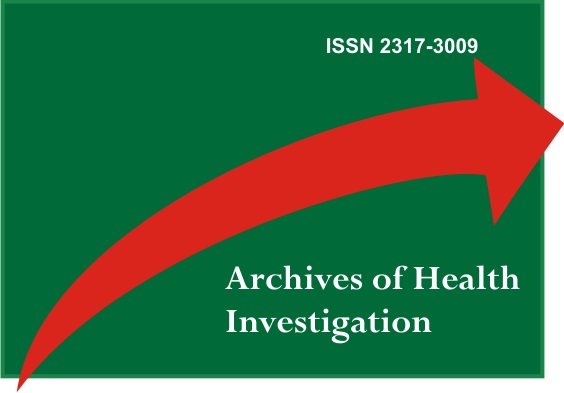Action of Botulinic Toxin in Temporomandibular Dysfunction
DOI:
https://doi.org/10.21270/archi.v11i1.5597Keywords:
Botulinum Toxins, Temporomandibular Joint Dysfunction Syndrome, Drug TherapyAbstract
Introduction: Botulinum toxin is used in the therapy of temporomandibular disorders (TMD) because it is a low-invasive, fast, safe technique that shows good results. Objective: was to conduct a literature review on botulinum toxin in TMD therapy. Material and Method: A bibliographic survey was carried out in the databases: Virtual Health Library, Bireme, LILACS, MEDLINE, PubMed and Scielo. Articles that contained therapeutic protocols suggesting the indication of botulinum toxin in the control of pain of myogenic origin in TMD, published between 2005 and 2019, were included in a completed version on the internet. Tests on animals or for aesthetic purposes are excluded. The descriptors were used: Botulinum Toxins Type A; Temporomandibular Joint Dysfunction Syndrome; Pharmacological treatment, combined by the Boolean operator AND. Results: From a universe of 104 articles, 18 were selected. Data were collected as: mechanism of action of 6 commercial brands; indications and contraindications; treatment of TMD; and, major complications in the use of the toxin. Conclusion: The botulinum toxin should be used in addition to the multidisciplinary treatment of TMD, because, despite presenting satisfactory and effective results, this cannot be the only treatment, since the dysfunction has a multifactorial etiology.
Downloads
References
Gauer RL, Semidey MJ. Diagnosis and Treatment of Temporomandibular Disorders. Am Fam Physician. 2015;91(6):378-86.
Bogucki ZA, Kownacka M. Clinical aspects of the use of botulinum toxin type a in the treatment of dysfunction of the masticatory system. Adv Clin Exp Med. 2016;25(3):569-73.
Awan KH, Patil S, Alamir AWH, Maddur N, Arakeri G, Carrozzo M, et al. Botulinum toxin in the management of myofascial pain associated with temporomandibular dysfunction. J Oral Pathol Med. 2019;48(3):192-200.
Calis AS, Colakoglu Z, Gunbay S. The use of botulinum toxin-a in the treatment of muscular temporomandibular joint disorders. J Stomatol Oral Maxillofac Surg. 2019;120(4):322–5.
Grossmann E, Grosmann TK, Cirurgia da articulação temporomandibular. Rev Dor. São Paulo, 2011.12(2):152-9
Ahmad M, Schiffman EL. Temporomandibular joint disorders and orofacial pain. Dent Clin N Am 2016;60:105-24.
Rossi SS, Greenberg MS, Liu F, Steinkeler A. Temporomandibular Disorders: Evaluation and Management. Med Clin N Am 2014;98(6): 1353-84.
Chisnoiu AM, Picos AM, Popa S, Chisnoiu PD, Lascu L, Picos A et al. Factors involved in the etiology of temporomandibular disorders - a literature review. Clujul Med. 2015;88(4):473-78.
McNeely ML, Armijo OS, Magee DJ. A systematic review of the effectiveness of physical therapy interventions for temporomandibular disorders. Phys Ther. 2006;86(5):710-25.
Feng J, Luo M, Ma J, Tian Y, Han X, Bai D. The treatment modalities of masticatory muscle pain a network meta-analysis. Medicine (Baltimore). 2019;98(46):e17934.
Majid OW. Clinical use of botulinum toxins in oral and maxillofacial surgery. Int. J. Oral Maxillofac. Surg. 2010;39(3):197-207.
Dressler D; Saberi, FA; Barbosa, ER. Botulinum toxin: mechanisms of action. Arq. Neuro Psiquiatr. 2005;63(1):180-85.
Sposito, MMM. Toxina Botulínica do Tipo A: mecanismo de ação. Acta Fisiatr 2009;16(1):25-37.
Dressler, D. Clinical applications of botulinum toxin. Curr Opin Microbiol. 2012;15(3):325-36.
Carruthers J, Carruthers A. Botox: beyond wrinkles. Clin Dermatol. 2004;22(1):89-93.
Botox. 2005. Disponivel em: www.allergan.com.br , acesso em 5 de Agosto, 2018.
Wenzel, RG. Pharmacologyc of Botulinum Neurotoxin Serotype A. AM J Heath Syst Pharm, 2004;61(6)55-60
Colhado, OCG; Boeing, M; Ortega, LB. Toxina Botulínica no Tratamento da Dor: artigo de revisão. Rev Bras Anestesiol. 2009;59(3):366-81.
Marciano A, Aguiar U, Vieira PGM, Magalhães SR. Toxina Botulínica e sua aplicação na odontologia. Rev Inic Cient UninCor. 2014; 4(1):65-75
Hoque A, McAndre M. Use of Botulinum Toxin Indestistry. N Y State Dent J. 2009;75(6):52-5.
Pihut M, Ferendiuk E, Szewczyk M, Kasprzyk K, Wieckiewicz M. The efficiency of botulinum toxin type A for the treatment of masseter muscle pain in patients with temporomandibular joint dysfunction and tension type headache. J Headache Pain. 2016;17:29.
Carrara SV, Conti PCR, Juliana SB. Termo do 1º Consenso em Disfunção Temporomandibular e dor Orofacial. Dental Press J Orthod. 2010; 15(3):114-20
Bueno, GH. Uso da toxina botulínica no tratamento de desordens temporomandibulares. Dísponível em: <https://repositorio.unesp.br/bitstream/handle/11449/149595/000869729.pdf?sequence=1>. Acesso em: 16 Out, 2018.
Rafferty KL, Liu ZJ, Ye W, Navarrete AL, Nguyen TT, Salamati A et al. Botulinum toxin in masticatory muscles: Short- and long-term effects on muscle, bone, and craniofacial function in adult rabbits. Bone.50(3):651-62.
Freund B, Schwartz M, Symington JM.Botulinum toxin: new treatment fortemporomandibular disorders. Br J OralMaxillofac Surg 2000;38(5):466-71
Clarck GT, Stiles A, Lockerman LZ, Gross SG. A Critical Review of the Use of Botulinum Toxin in Orofacial Pain Disorders. Dent Clin North Am. 2007; 51(1):245-61.
Amantéa DV, Novaes AP, Campolongo GD, Pessoa de Barros T. A utilização da toxina botulínica tipo A na dor e disfunção temporomandibular. JBA, Curitiba. 2003;10:170-73.
Kurtoglu C, Gur OH, Kukcu M, Sertdemir Y, Guler-Uysal, Uysal H. Effect of botulinum toxin a in myofascial pain patients with or without functional disc displacement. J Oral Maxillofac Surg. 2008;66(8):1644-51.
Ernberg M, Hedenberg-Magnusson B, List T, Svensson P. Efficacy of botulinum toxintype A for treatment of persistent myofascial TMD pain: a randomized, controlled,double-blind multicenter study. Pain. 2011;152(9):1988-96.
Bartley J. Breathing and temporomandibular joint disease. J Bodyw Mov. 2011;15(3):291-97.


